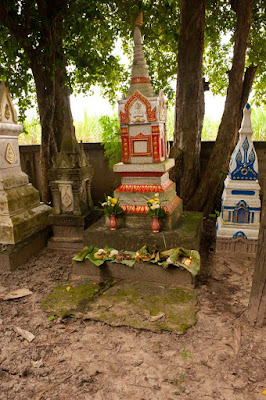 |
| Popping Rice In Isaan |
I first encountered the Isaan specialty, Kao Tawtek, seven years ago. I often refer to Kao Tawtek as "Thai Cracker Jacks"
Cracker Jacks are treat for the past 129 years in the United States. They are molasses flavored, caramel covered kernels of popcorn and peanuts.
Early September is the time, when Lao Loum families gather together to make Kao Tawtek. Rice is one of the main components of the delicious treat. Last year's harvest of rice is stored in small raised sheds adjacent to each house. Large 50 kilogram (110 pound) recycled fertilizer bags, sugar bags, and rice bags are filled with sun dried rice kernels each October and November. The bags are kept in the raised granaries and removed as needed to feed the family or opened to obtain offerings at special events such as funerals, bone parties, Tambon Roy Wan -100 day death anniversary, weddings, and Monk ordinations. Families who are unable to make offerings of cash, make donations of rice. The cash as well as the rice are then offered to the Monks in merit making rituals.
The stored rice has husk in tact. In order to eat the rice, the rice is brought to a local miller to remove the husk, rendering the rice to the state that most people in the USA are familiar with at their grocery store. Many bags of rice are not milled in Isaan because they are the seed stock for next year's crop. Other bags of unmilled rice are saved to make kao tawtek.
I suspect that it is not by coincidence that the time to make kao tawtek is a month before the harvest of this year's rice crop. Families now know how much rice they have as surplus from the last harvest, so that are able to make the special treat without fear of running out of rice before the new harvest is available.
Early last month, after our return from Vietnam, we drove out to Thasang Village. Members of Duang's extended and extensive family were popping rice as part of the process to make this year's Kao Tawtek.
The sound of the popping rice seed, the swirling smoke, the swishing sound of the stiff reeds on hot metal, the sight of white rice puffs bursting upwards, and the smell of a wood fire all created quite a sensory explosion. The shelter of the overhanging roof ensured that the pending rain would not interfere with the activity.
Occasionally another woman would stoop down and tend the fire. Most of the time tending the fire was adding just a couple more inches of the small pieces of wood into the fire. Other times tending the fire involved splashing some water on the coals to maintain a desired temperature in the wok - too hot a temperature would end up quickly burning the popped rice before it could be removed.
As the popping came to a conclusion, another woman would approach the fire to take hold of the large metal bowl that had been used over the top of the wok. She held the bowl at an angle as she swept the hot rice puffs into it.
The plan for the day was only to pop the rice and to wait until another day to cook in the sugar, millet, coconut, peanuts and package the delicious treat.
The work proceeded with a great deal of laughing and talking - very little transpires here in Isaan without a great deal of talking and gossiping.
The Kao Tawtek is finished for Wan Kao Saht the Mid Autumn (Moon) Festival. On this day, the Lao Loum people of Isaan make offerings to the hungry phii (ghosts). In making the offerings to the phii, the people ask the ghosts to watch over and take care of this year's rice crop which will be harvested in October and November. Close to the harvest, the people want to ensure that there are no problems with the crop. The kao tawtek is a special treat for the spirits.
Kao Tawtek is also offered to the Monks as they complete roughly 60 days of the 90 day Buddhist Lent also referred as the Buddhist Rains Retreat. Families can also make extra income by selling surplus kao tawtek to people who want and need it but are not able or willing to make it themselves.
The Lao Loum people, be they living in Thailand or in the Lao People's Democratic Republic (Laos), may not live in "the land of the free ..." but they are free to make a living without cumbersome regulation. My experience is also the same for the people of Vietnam.


























































